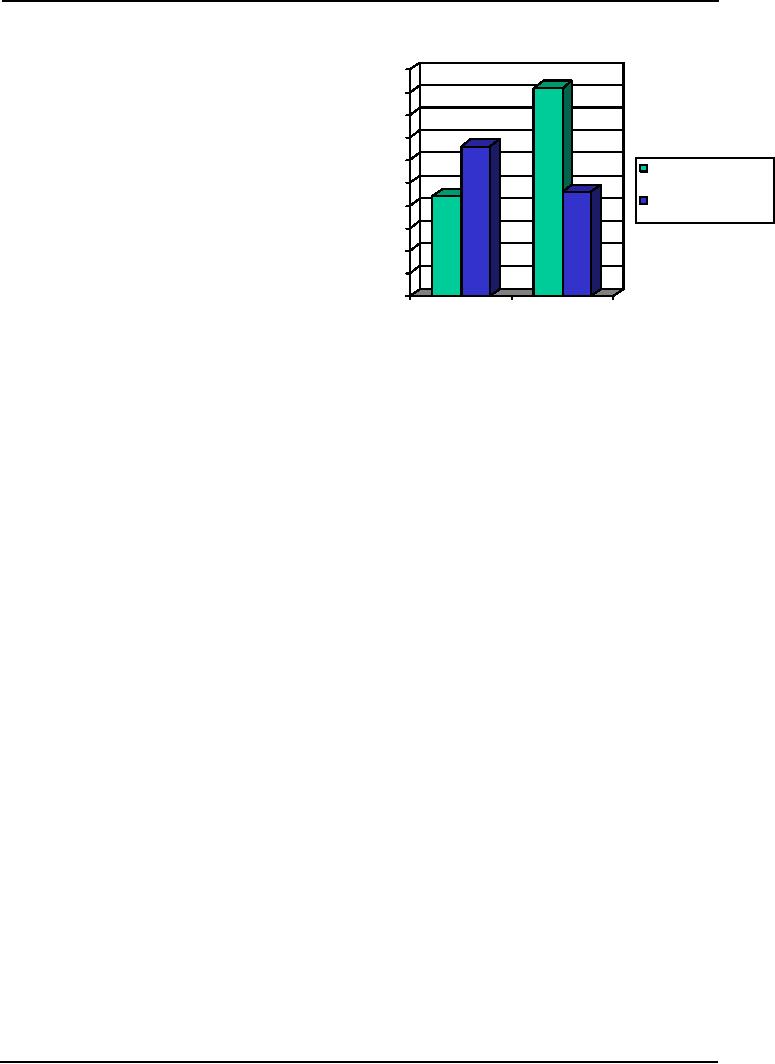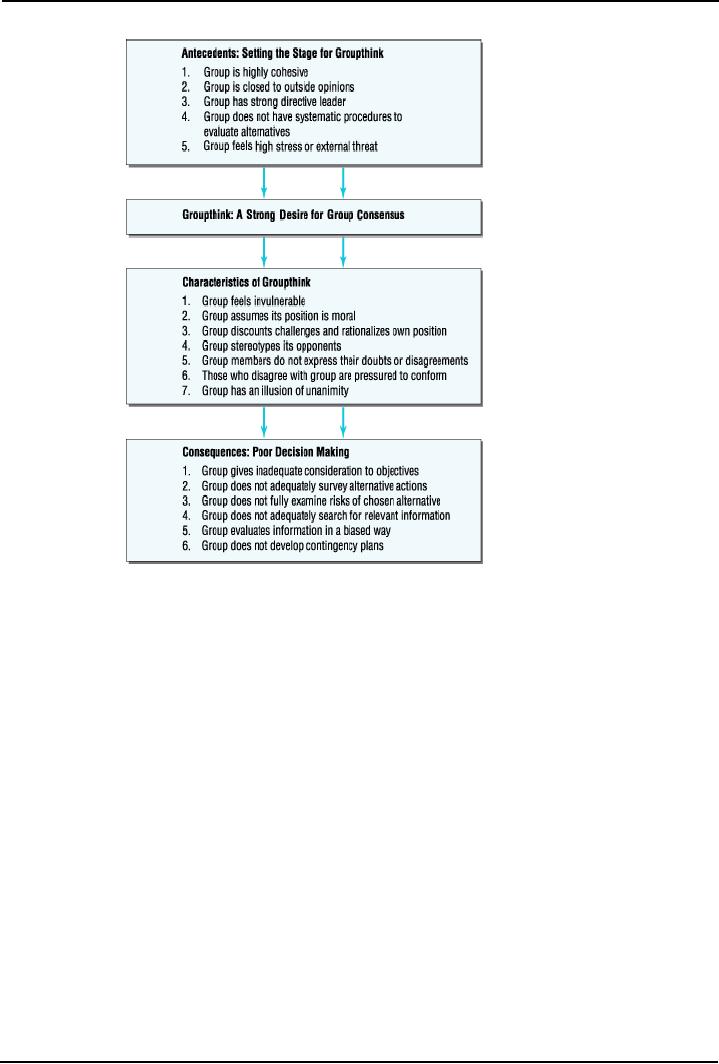 |

Social
Psychology (PSY403)
VU
Lesson
41
GROUP
BEHAVIOR (CONTINUE..........)
David
Dodd's Exercise relevant to previous
lecture # 40
David
David Dodd describes a
highly effective and entertaining
exercise that illustrates
the concept of
deindividuation.
According to Dodd, the object of
this exercise is to demonstrate
that even normal,
well-
adjusted
college students are capable
of deviant, antisocial behavior
given the right situational
conditions
(e.g.,
feelings of anonymity and
irresponsibility). The procedure of the
experiment is as under:
·
Please
respond anonymously to the following
question:
"If
you could be totally
invisible for 24 hours and
were completely assured that you
would not be
detected
or held responsible for your
actions, what would you
do?"
·
The
average number of antisocial responses
given by Dodd's college
students (36%) is no different
than
the
number of antisocial responses given by
inmates at a maximum security
prison where he once
taught.
Group
Behavior Lesson # 41
Aims
To
introduce the psychological effects of
being in a group and of
interacting with others on an
inter-
individual
level
Objectives
·
Describe the
process of group decisions
·
Evaluate
the effects of `Groupthink'
Group
Decision Process
Group
decision making and the `risky
shift'
·
The
`risky shift' describes the tendency
for people to accept more
risky odds when considering
a
dilemma
in a group (Stoner,
1961)
·
Stoner
(1961) asked management
students to individually respond to 12
hypothetical dilemmas. Then he
brought
them together in groups and instructed to
discuss until they reached a
unanimous decision. He
found
out that after discussion
the group was ready to take
more risks.
·
During
the next five years,
subsequent research found the
same results across a wide
variety of age and
occupational
groups, and in dozens of different
cultures.
·
Same
results have been obtained
across diverse occupational, age, and
cultural groups.
·
But
not all decision dilemmas
reached risky shift.
Sometimes people become more cautious in
groups
(Knox
& Safford, 1976)
·
How
could group discussion produce
both greater risk taking and greater
conservatism?
Group
Polarization
·
It is not that
people become more risky or cautious in
groups per se but rather the group's
initial
attitudes
are enhanced or
polarized.
·
After group
discussion members' initial attitudes
become exaggerated. It is actually
strengthening of
initial
attitudes.
·
More likely to
occur with important issues
(Kerr, 1992)
173

Social
Psychology (PSY403)
VU
Research
findings:
·
Groups initially
low or high in prejudice were even
less or more after discussion
(Myers & Bishop,
1970)
·
Terrorist
organizations became more extreme
gradually over time
(McCauley & Segal, 1987)
·
Members of jury
held more extreme opinions about a
defendant guilty or innocent
(Myers & Kaplan,
1976)
The
process of group polarization:
In
group polarization, discussion by
group members enhances the
initial attitudes or views of
those
who
already agree, regardless
whether those views reflect
caution or risk. Researches
indicate that
group
polarization is more likely to occur on
important issues rather than
trivial ones.
Explanations
for group polarization
·
Social
comparison
·
We
are motivated to self
evaluate by comparing us with others.
They want others to evaluate
them
positively,
and after discussion they
find out that they
are not nearly as extreme in the
socially valued
direction
than others as they
initially thought. So they
begin to shift toward even more
extreme
positions.
Comparisons with others promotes a desire
to fit in with socially
valued ideals so attitudes
become
more extreme (normative influence)
·
Mutual
persuasion
·
In
group discussion people
learn more (encounter more arguments) so are more
persuaded
(informational
influence). The desire is
not to be evaluated positively
but the desire to arrive
at
correct
or true solution. Hearing
new supportive arguments
that they had not initially
considered,
members
gradually come to adopt even more extreme
positions. It is arguments in favour of
their
own
position rather than against
it.
·
Daniel
Isenberg's meta-analysis of 21 different
group polarization studies:
Social comparison and
persuasive
arguments
often occur in combination
to
produce extreme group decisions
Types
of influences leading to
polarization
·
How
these two could produce
group
Type
of
Goal
Thoughts
Actions
polarization?
influence
·
In
issues involving intellectual
tasks
Discover
Adopt
an
Normative
To
be
when
facts are weighed
group,
other
opinion
that
influence
likeable
members
are primarily concerned
with
members'
is
socially
the
information presented in
people's
opinions
desirable
arguments.
When it is judgmental
than
the
task,
and there is not clear right or
average
wrong
answer, people are more
likely
opinion
to
compare their views with
others.
Informational
To
be right
Attend
to
Shift
opinion
Martin
Kaplan (1987) suggests
that
influence
persuasive
in
direction
they
may operate in
different
arguments
indicated
by
situations:
issues involving
intellectual
vs.
judgmental tasks
novel,
valid
arguments
Table
1 shows different types of influences
leading to polarization:
174

Social
Psychology (PSY403)
VU
Groupthink
·
An
extreme form of group polarization
(Janis, 1982) March 19
2003
·
A
deterioration in mental efficiency,
reality testing, and moral
judgment in groups due to an
excessive
desire
to achieve consensus
·
Example:
On March 19, 2003 President Bush ordered
the invasion of Iraq. The CIA had
provided
evidence
that Iraq possessed weapons
of mass destruction, and Saddam
was planning terrorist
attacks
along
with Usama bin Laden. Bush
hoped that the Iraqi people
would welcome the invading force,
and
USA
would become a beacon of
light for all people in the
Middle East, but that
was proved wrong as
they
could find any weapons.
American soldiers are being
killed daily along with
Iraqis. The US senate
select
committee on intelligence issued a very
critical report on this
decision.
·
Senate
Committee member Rockefeller
stated "our credibility is
diminished. Our standing has
never
been
lower. We have fostered a great hatred of America in
the Muslim world"
Groupthink
caused by...
·
High
in-group cohesiveness
(conformity)
·
Janis
(1971) stated that
cohesiveness is a positive group
characteristic but it is also associated
with
conformity.
When people are strongly
attached to group, they want
badly to be accepted. When it
is
combined
with the other two factors, groups
become more susceptible to group
think.
·
Threatening
situational context
·
At
the time of stress people
become dependent on the reassuring support of others,
which would
increase
the group's influence on individual
members.
·
Stressful
situations lead to people
valuing speed over
accuracy
·
Structural/procedural
faults
·
Lack
of systematic checks, isolation of the
group, and a directive
leader; directive leader who
lets
other
members know what his
inclinations are regarding the
group's final decision choice
may lead to
groupthink.
Turner
et al. (1992):
·
Investigated
both cohesiveness and stressful
threat
·
Created
high and low cohesiveness groups; gave
names to each of the "high
cohesiveness" groups and
had
them wear tags bearing group
name. "Low cohesiveness"
received neither tags nor
group identities
·
The
problem was that some
workers producing automobile
panels had decreased productivity,
while one
worker
Joe was piling up his
work.
·
Asked
all groups to recommend a solution
for an automobile production
problem
·
Rank
order of possible solutions was
suggested:
·
promoting
Joe was a low quality
solution
·
Removing
him from his station
was a medium quality
decision.
·
high
quality decision was
rotating workers on an hourly
base, so that pile up does
not occur
·
Told
high threat group that their
session will be videotaped
for using in subsequent
sessions, and their
evaluation
will be used to evaluate
"dysfunctional group
processes".
175

Social
Psychology (PSY403)
VU
·
An
interaction between cohesiveness and
threat
was
observed.
5
Figure
1 shows
that when cohesive group
became
4.5
threatened
they made low
quality decisions
4
indicating
group think (0 indicate very
low quality
3.5
decision)
3
Low
coh e si ve groups
2.5
Symptoms
of groupthink
Hi
gh cohe si ve
2
grou
ps
Overestimation
of the competence of the
in-
1.5
group:
1
·
Illusion
of invulnerability and an unquestioned
0.5
belief
in the in-group's own
morality.
0
American
president and his colleagues
thought
Low
thre at
Hi
gh th re at
that
USA will crush armed
oppositions and
will
win the hearts and minds of Iraqi.
Same is
true
for USA's observation for
Afghanistan.
Close-mindedness:
·
Bush
and his administration did
not examine the evidence that
would have confirmed the existence
of
weapons.
Members of close-minded group rationalize
the correctness of their
decisions.
Increased
conformity:
·Members reject those
who raise doubts about the
group's assumptions and decisions, and
they censor
their
own misgivings. With all
this conformity pressure,
members develop an illusion
that everyone is in
agreement.
·
Groupthink is more
when there is a lot of loyalty,
and not much intellectual
diversity within a
decision
making
body.
176

Social
Psychology (PSY403)
VU
Janis's
Theory
Of
Group-
think
Figure
2 shows Janis's theory of
groupthink:
Tetlock's
study (1992)
·
Tetlock
tested Janis theory of
groupthink and presented content analysis of the
factual accounts of 10
historic
decisions that potentially involved
groupthink
·
Historic
events involving disastrous decisions
exhibited significantly more group
decision
·
Some
of groupthink characteristics were suspicion of
outsiders, restriction of information exchange,
and
punishment
of group dissenters
Overcoming
groupthink
·
Leader
remains impartial and encourages the
expression of dissent
·
Use
separate subcommittees to discuss
same issue separately
·
Consult
outside experts
·
Making
decisions in this way will
facilitate the type of critical analysis
that is the hallmark of
success,
both
on the individual and group
level.
Reading:
·
Franzoi, S.
(2003). Social
Psychology. Boston:
McGraw-Hill. Chapter 10.
177

Social
Psychology (PSY403)
VU
Other
Readings:
·
Lord,
C.G. (1997). Social
Psychology. Orlando:
Harcourt Brace and Company. Chapter
8.
·
David G.
Myers, D. G. (2002). Social
Psychology (7th ed.).
New York:
McGraw-Hill.
·
Taylor,
S.E. (2006). Social
Psychology (12th ed.). New
York: Prentice Hall.
178
Table of Contents:
- INTRODUCTION TO SOCIAL PSYCHOLOGY:Readings, Main Elements of Definitions
- INTRODUCTION TO SOCIAL PSYCHOLOGY:Social Psychology and Sociology
- CONDUCTING RESEARCH IN SOCIAL PSYCHOLOGY:Scientific Method
- CONDUCTING RESEARCH IN SOCIAL PSYCHOLOGY:Evaluate Ethics
- CONDUCTING RESEARCH IN SOCIAL PSYCHOLOGY RESEARCH PROCESS, DESIGNS AND METHODS (CONTINUED)
- CONDUCTING RESEARCH IN SOCIAL PSYCHOLOGY OBSERVATIONAL METHOD
- CONDUCTING RESEARCH IN SOCIAL PSYCHOLOGY CORRELATIONAL METHOD:
- CONDUCTING RESEARCH IN SOCIAL PSYCHOLOGY EXPERIMENTAL METHOD
- THE SELF:Meta Analysis, THE INTERNET, BRAIN-IMAGING TECHNIQUES
- THE SELF (CONTINUED):Development of Self awareness, SELF REGULATION
- THE SELF (CONTINUE…….):Journal Activity, POSSIBLE HISTORICAL EFFECTS
- THE SELF (CONTINUE……….):SELF-SCHEMAS, SELF-COMPLEXITY
- PERSON PERCEPTION:Impression Formation, Facial Expressions
- PERSON PERCEPTION (CONTINUE…..):GENDER SOCIALIZATION, Integrating Impressions
- PERSON PERCEPTION: WHEN PERSON PERCEPTION IS MOST CHALLENGING
- ATTRIBUTION:The locus of causality, Stability & Controllability
- ATTRIBUTION ERRORS:Biases in Attribution, Cultural differences
- SOCIAL COGNITION:We are categorizing creatures, Developing Schemas
- SOCIAL COGNITION (CONTINUE…….):Counterfactual Thinking, Confirmation bias
- ATTITUDES:Affective component, Behavioral component, Cognitive component
- ATTITUDE FORMATION:Classical conditioning, Subliminal conditioning
- ATTITUDE AND BEHAVIOR:Theory of planned behavior, Attitude strength
- ATTITUDE CHANGE:Factors affecting dissonance, Likeability
- ATTITUDE CHANGE (CONTINUE……….):Attitudinal Inoculation, Audience Variables
- PREJUDICE AND DISCRIMINATION:Activity on Cognitive Dissonance, Categorization
- PREJUDICE AND DISCRIMINATION (CONTINUE……….):Religion, Stereotype threat
- REDUCING PREJUDICE AND DISCRIMINATION:The contact hypothesis
- INTERPERSONAL ATTRACTION:Reasons for affiliation, Theory of Social exchange
- INTERPERSONAL ATTRACTION (CONTINUE……..):Physical attractiveness
- INTIMATE RELATIONSHIPS:Applied Social Psychology Lab
- SOCIAL INFLUENCE:Attachment styles & Friendship, SOCIAL INTERACTIONS
- SOCIAL INFLUENCE (CONTINE………):Normative influence, Informational influence
- SOCIAL INFLUENCE (CONTINUE……):Crimes of Obedience, Predictions
- AGGRESSION:Identifying Aggression, Instrumental aggression
- AGGRESSION (CONTINUE……):The Cognitive-Neo-associationist Model
- REDUCING AGGRESSION:Punishment, Incompatible response strategy
- PROSOCIAL BEHAVIOR:Types of Helping, Reciprocal helping, Norm of responsibility
- PROSOCIAL BEHAVIOR (CONTINUE………):Bystander Intervention, Diffusion of responsibility
- GROUP BEHAVIOR:Applied Social Psychology Lab, Basic Features of Groups
- GROUP BEHAVIOR (CONTINUE…………):Social Loafing, Deindividuation
- up Decision GROUP BEHAVIOR (CONTINUE……….):GroProcess, Group Polarization
- INTERPERSONAL POWER: LEADERSHIP, The Situational Perspective, Information power
- SOCIAL PSYCHOLOGY APPLIED: SOCIAL PSYCHOLOGY IN COURT
- SOCIAL PSYCHOLOGY APPLIED: SOCIAL PSYCHOLOGY IN CLINIC
- FINAL REVIEW:Social Psychology and related fields, History, Social cognition